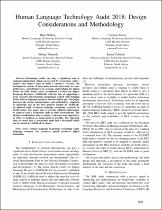JavaScript is disabled for your browser. Some features of this site may not work without it.
- ResearchSpace
- →
- Research Publications/Outputs
- →
- Conference Publications
- →
- View Item
| dc.contributor.author |
Wilken, Ilana

|
|
| dc.contributor.author |
Gumede, Tebogo

|
|
| dc.contributor.author |
Moors, Carmen

|
|
| dc.contributor.author |
Calteaux, Karen V

|
|
| dc.date.accessioned | 2019-01-16T11:13:56Z | |
| dc.date.available | 2019-01-16T11:13:56Z | |
| dc.date.issued | 2018-12 | |
| dc.identifier.citation | Wilken, I. et al. 2018. Human Language Technology Audit 2018: Design Considerations and Methodology. 2018 International Conference on Intelligent & Innovative Computing Applications (ICONIC), Holiday Inn Mon Tresor, Mauritius, 6-7 December 2018 | en_US |
| dc.identifier.isbn | 978-1-5386-6476-6 | |
| dc.identifier.uri | http://mauricon.org/wp-content/uploads/2018/12/Mauricon-2018-Conference-Proceedings-44423-041218.pdf | |
| dc.identifier.uri | http://hdl.handle.net/10204/10604 | |
| dc.description | Paper presented at the 2018 International Conference on Intelligent & Innovative Computing Applications (ICONIC), Holiday Inn Mon Tresor, Mauritius, 6-7 December 2018 | en_US |
| dc.description.abstract | Technology audits can play a significant role in surfacing information which can be used by researchers, policymakers and funders alike to build a country’s research and development system of innovation towards increasing its competitiveness, contributing to its economy and bridging the digital divide. In 2016, South Africa established a Centre for Digital Language Resources (SADiLaR) with the aim of supporting a large research infrastructure programme tasked with bringing South African language resources into the digital age. This paper discusses the design considerations and methodology employed to undertake one of the first projects funded by SADiLaR: an updated audit of human language technology resources in South Africa. The paper aims to provide sufficient information to replicate such a technology audit in other environments. The design considerations aim to ensure a pleasant user experience, in order to facilitate as much input as possible. The approach aims to ensure that a sustainable audit tool is developed which can be hosted by SADiLaR in future. | en_US |
| dc.language.iso | en | en_US |
| dc.relation.ispartofseries | Worklist;21832 | |
| dc.subject | Digital humanities | en_US |
| dc.subject | Human language technology | en_US |
| dc.subject | Language resources | en_US |
| dc.subject | Speech resources | en_US |
| dc.subject | Technology audit | en_US |
| dc.subject | Text resources | en_US |
| dc.title | Human Language Technology Audit 2018: Design Considerations and Methodology | en_US |
| dc.type | Conference Presentation | en_US |
| dc.identifier.apacitation | Wilken, I., Gumede, T., Moors, C., & Calteaux, K. V. (2018). Human Language Technology Audit 2018: Design Considerations and Methodology. http://hdl.handle.net/10204/10604 | en_ZA |
| dc.identifier.chicagocitation | Wilken, Ilana, Tebogo Gumede, Carmen Moors, and Karen V Calteaux. "Human Language Technology Audit 2018: Design Considerations and Methodology." (2018): http://hdl.handle.net/10204/10604 | en_ZA |
| dc.identifier.vancouvercitation | Wilken I, Gumede T, Moors C, Calteaux KV, Human Language Technology Audit 2018: Design Considerations and Methodology; 2018. http://hdl.handle.net/10204/10604 . | en_ZA |
| dc.identifier.ris | TY - Conference Presentation AU - Wilken, Ilana AU - Gumede, Tebogo AU - Moors, Carmen AU - Calteaux, Karen V AB - Technology audits can play a significant role in surfacing information which can be used by researchers, policymakers and funders alike to build a country’s research and development system of innovation towards increasing its competitiveness, contributing to its economy and bridging the digital divide. In 2016, South Africa established a Centre for Digital Language Resources (SADiLaR) with the aim of supporting a large research infrastructure programme tasked with bringing South African language resources into the digital age. This paper discusses the design considerations and methodology employed to undertake one of the first projects funded by SADiLaR: an updated audit of human language technology resources in South Africa. The paper aims to provide sufficient information to replicate such a technology audit in other environments. The design considerations aim to ensure a pleasant user experience, in order to facilitate as much input as possible. The approach aims to ensure that a sustainable audit tool is developed which can be hosted by SADiLaR in future. DA - 2018-12 DB - ResearchSpace DP - CSIR KW - Digital humanities KW - Human language technology KW - Language resources KW - Speech resources KW - Technology audit KW - Text resources LK - https://researchspace.csir.co.za PY - 2018 SM - 978-1-5386-6476-6 T1 - Human Language Technology Audit 2018: Design Considerations and Methodology TI - Human Language Technology Audit 2018: Design Considerations and Methodology UR - http://hdl.handle.net/10204/10604 ER - | en_ZA |






